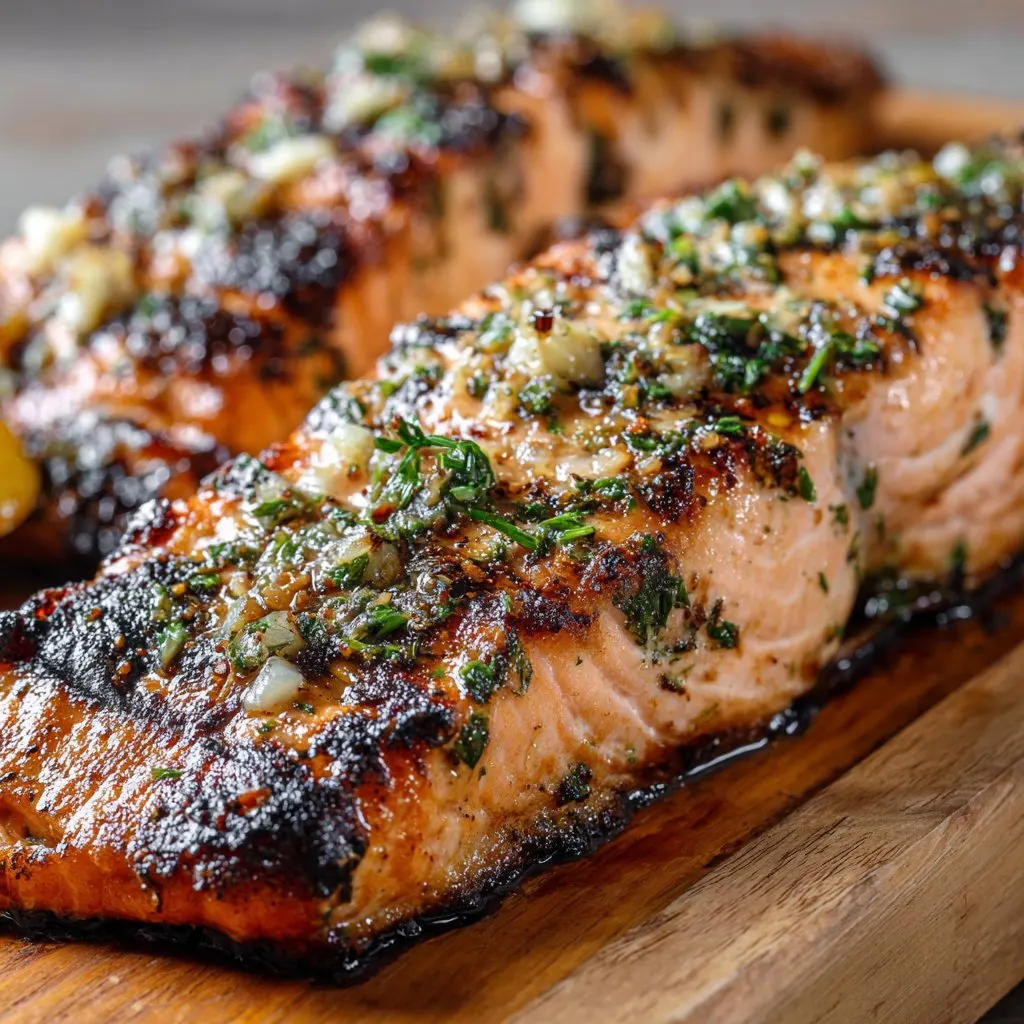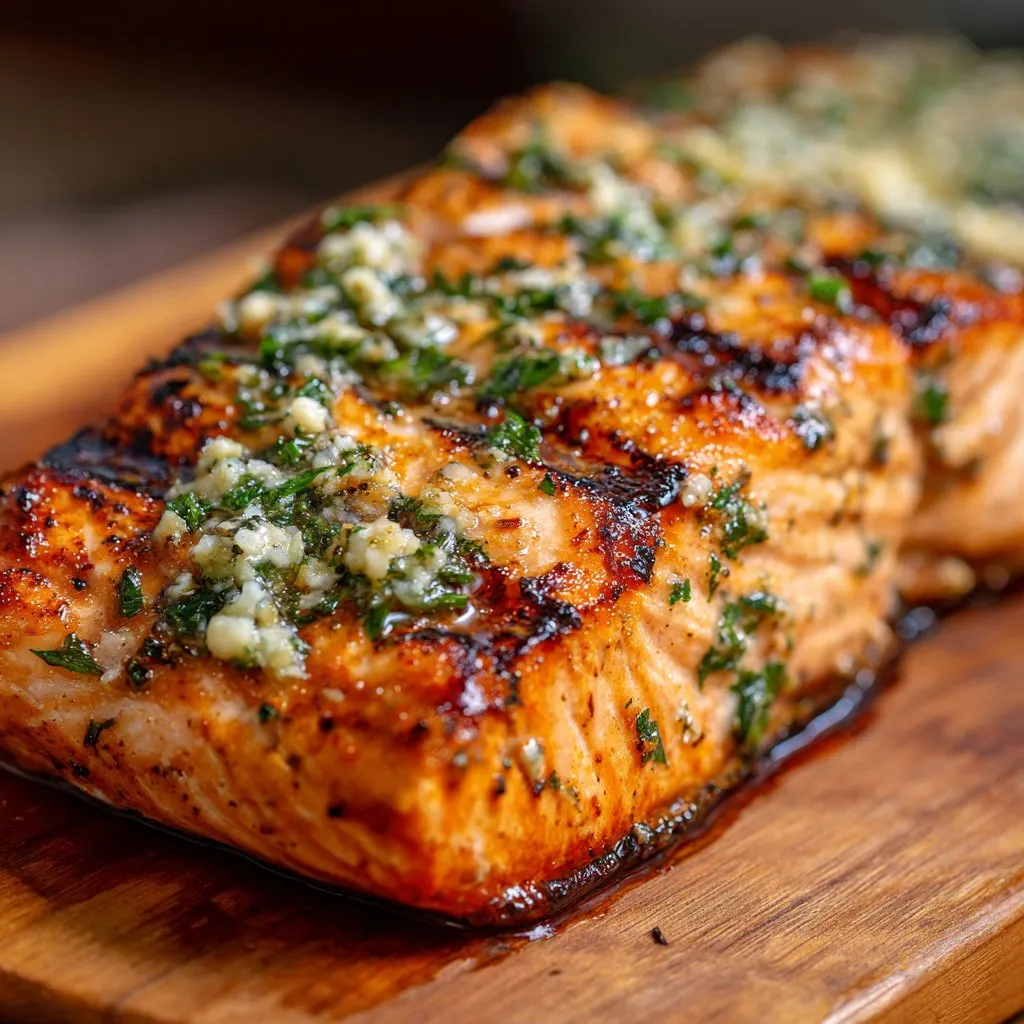Hey y'all! If you're searching for a foolproof way to enjoy tender, juicy salmon bursting with zesty flavor, this Grilled Salmon with Garlic Lemon Marinade is sure to hit the spot. It's the ultimate crowd-pleaser—perfect for summer barbecues, healthy weeknight dinners, or impressing guests at your next gathering. The savory marinade infuses each bite with bright citrus, aromatic garlic, and a hint of fresh herbs. Let’s get cooking!
Why You'll Love This Grilled Salmon with Garlic Lemon Marinade
- Quick and easy for weeknights—just 10 minutes of prep and 8-10 minutes on the grill.
- Rich, flaky salmon paired with a vibrant, tangy marinade that enhances natural flavors.
- Healthy and packed with omega-3s, perfect for balanced eating.
- Versatile for outdoor grilling, stovetop grill pans, or even the oven.
- Minimal cleanup and simple ingredients you probably already have in your kitchen.
Ingredients for Grilled Salmon with Garlic Lemon Marinade
- 4 salmon fillets (about 6 oz each), skin-on recommended
- 3 tablespoons fresh lemon juice (about 1 large lemon)
- 2 tablespoons olive oil
- 3 cloves garlic, minced
- 1 tablespoon chopped fresh parsley
- 1 teaspoon Dijon mustard
- 1 teaspoon honey or maple syrup
- ½ teaspoon salt
- ¼ teaspoon black pepper
- Lemon slices, for garnish (optional)
How to Make Grilled Salmon with Garlic Lemon Marinade
Step 1: Prepare the Marinade
In a small bowl, whisk together lemon juice, olive oil, minced garlic, Dijon mustard, honey, parsley, salt, and pepper until well combined.
Step 2: Marinate the Salmon
Place the salmon fillets in a large resealable bag or shallow dish. Pour the marinade over the salmon, ensuring each piece is evenly coated. Seal or cover and refrigerate for 20-30 minutes (don’t marinate longer to prevent the acid from "cooking" the fish).
Step 3: Preheat and Prep the Grill
Preheat your grill to medium-high heat (400°F/200°C). Clean and oil the grates to help prevent sticking.
Step 4: Grill the Salmon
Remove salmon from the marinade and shake off excess. Place salmon skin-side down on the grill. Close the lid and cook for 4-5 minutes per side, or until the salmon is opaque and flakes easily with a fork (internal temp 125-130°F for medium-rare).
Step 5: Serve
Transfer the grilled salmon to a platter, garnish with fresh parsley and lemon slices, and serve immediately for best texture and flavor.

Notes for the Best Grilled Salmon with Garlic Lemon Marinade
- For extra flavor, reserve a tablespoon of marinade (before adding fish) to drizzle on after grilling.
- If you don’t have fresh herbs, dried parsley or dill works in a pinch—use 1 teaspoon dried per tablespoon fresh.
- Learn more about grilling fish safely from Serious Eats' grilling guide.
Variations on Grilled Salmon with Garlic Lemon Marinade
- Asian Twist: Add a tablespoon of soy sauce and a teaspoon of grated ginger to the marinade.
- Spicy Kick: Toss in ¼ teaspoon red pepper flakes or a dash of sriracha.
- Herbaceous: Swap parsley for fresh dill or basil for a distinct twist.
Required Equipment for Grilled Salmon with Garlic Lemon Marinade
- Outdoor grill or stovetop grill pan
- Mixing bowl and whisk
- Basting brush (optional)
- Tongs or spatula
Storage Instructions for Leftover Grilled Salmon with Garlic Lemon Marinade
Leftover salmon can be stored in an airtight container in the refrigerator for up to 3 days. To reheat, place gently in a 300°F (150°C) oven for 8-10 minutes until just warmed through—avoid microwaving to prevent dryness. For more on safe seafood storage, see this FDA seafood guide.
Suggested Pairings for Grilled Salmon with Garlic Lemon Marinade
- Light quinoa salad with cucumbers and tomatoes
- Grilled asparagus or roasted Brussels sprouts
- Chilled white wine like Sauvignon Blanc or Pinot Grigio
Pro Tips for Grilled Salmon with Garlic Lemon Marinade
- Always preheat and oil your grill grates to prevent sticking and get beautiful grill marks.
- Use an instant-read thermometer to check for doneness (125-130°F for medium-rare); overcooked salmon can become dry.
- For tips on buying sustainable salmon, visit Monterey Bay Aquarium Seafood Watch.
FAQ about Grilled Salmon with Garlic Lemon Marinade
- Can I use frozen salmon fillets for this recipe?
- Yes, just thaw them completely in the fridge and pat dry before marinating for best results.
- What if I don’t have a grill?
- You can use a stovetop grill pan or bake at 400°F (200°C) for 12-15 minutes instead.
- How can I prevent the salmon from sticking to the grill?
- Make sure your grill is preheated and well-oiled, and avoid flipping the salmon too soon—wait until it naturally releases from the grates.
Prep time: 10 minutes | Marinate: 20-30 minutes | Cook time: 8-10 minutes | Total time: 40-50 minutes
Ingredients
- 4 salmon fillets (about 6 oz each)
- 3 tablespoons olive oil
- 2 tablespoons fresh lemon juice
- 3 garlic cloves, minced
- 1 teaspoon lemon zest
- 1 teaspoon salt
- ½ teaspoon black pepper
- 2 tablespoons chopped fresh parsley
Instructions
-
1In a small bowl, whisk together olive oil, lemon juice, minced garlic, lemon zest, salt, and black pepper.
-
2Place the salmon fillets in a shallow dish and pour the marinade over them. Cover and refrigerate for at least 10 minutes.
-
3Preheat the grill to medium-high heat. Lightly oil the grill grates.
-
4Remove the salmon from the marinade and place on the grill, skin-side down. Grill for 5-6 minutes per side, or until the salmon is cooked through and flakes easily with a fork.
-
5Transfer the grilled salmon to a serving platter and sprinkle with chopped fresh parsley. Serve with lemon wedges if desired.
Approximate Information for One Serving
Nutrition Disclaimers
Number of total servings shown is approximate. Actual number of servings will depend on your preferred portion sizes.
Nutritional values shown are general guidelines and reflect information for 1 serving using the ingredients listed, not including any optional ingredients. Actual macros may vary slightly depending on specific brands and types of ingredients used.
To determine the weight of one serving, prepare the recipe as instructed. Weigh the finished recipe, then divide the weight of the finished recipe (not including the weight of the container the food is in) by the desired number of servings. Result will be the weight of one serving.
Did you make this recipe?
Please consider Pinning it!!


